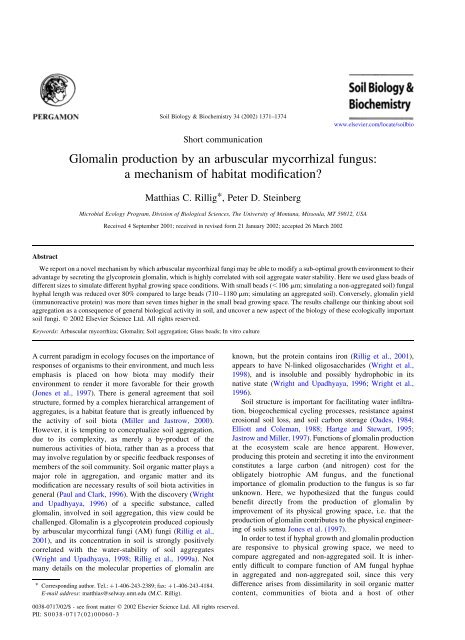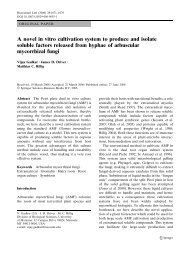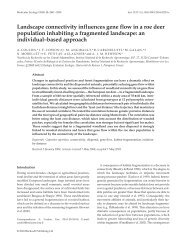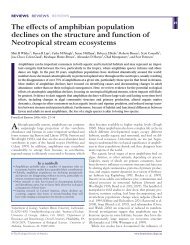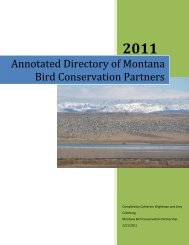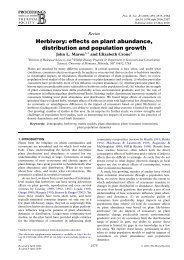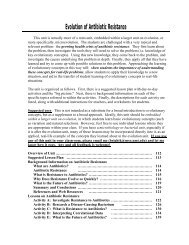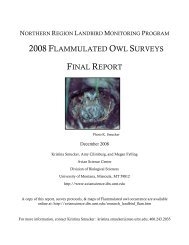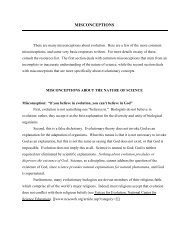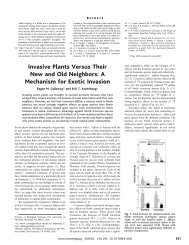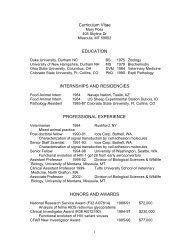Rillig M.C., Steinberg P.D. 2002. - Division of Biological Sciences ...
Rillig M.C., Steinberg P.D. 2002. - Division of Biological Sciences ...
Rillig M.C., Steinberg P.D. 2002. - Division of Biological Sciences ...
You also want an ePaper? Increase the reach of your titles
YUMPU automatically turns print PDFs into web optimized ePapers that Google loves.
Soil Biology & Biochemistry 34 (2002) 1371–1374<br />
Short communication<br />
Glomalin production by an arbuscular mycorrhizal fungus:<br />
a mechanism <strong>of</strong> habitat modification?<br />
Matthias C. <strong>Rillig</strong>*, Peter D. <strong>Steinberg</strong><br />
Microbial Ecology Program, <strong>Division</strong> <strong>of</strong> <strong>Biological</strong> <strong>Sciences</strong>, The University <strong>of</strong> Montana, Missoula, MT 59812, USA<br />
Received 4 September 2001; received in revised form 21 January 2002; accepted 26 March 2002<br />
www.elsevier.com/locate/soilbio<br />
Abstract<br />
We report on a novel mechanism by which arbuscular mycorrhizal fungi may be able to modify a sub-optimal growth environment to their<br />
advantage by secreting the glycoprotein glomalin, which is highly correlated with soil aggregate water stability. Here we used glass beads <strong>of</strong><br />
different sizes to simulate different hyphal growing space conditions. With small beads (,106 mm; simulating a non-aggregated soil) fungal<br />
hyphal length was reduced over 80% compared to large beads (710–1180 mm; simulating an aggregated soil). Conversely, glomalin yield<br />
(immunoreactive protein) was more than seven times higher in the small bead growing space. The results challenge our thinking about soil<br />
aggregation as a consequence <strong>of</strong> general biological activity in soil, and uncover a new aspect <strong>of</strong> the biology <strong>of</strong> these ecologically important<br />
soil fungi. q 2002 Elsevier Science Ltd. All rights reserved.<br />
Keywords: Arbuscular mycorrhiza; Glomalin; Soil aggregation; Glass beads; In vitro culture<br />
A current paradigm in ecology focuses on the importance <strong>of</strong><br />
responses <strong>of</strong> organisms to their environment, and much less<br />
emphasis is placed on how biota may modify their<br />
environment to render it more favorable for their growth<br />
(Jones et al., 1997). There is general agreement that soil<br />
structure, formed by a complex hierarchical arrangement <strong>of</strong><br />
aggregates, is a habitat feature that is greatly influenced by<br />
the activity <strong>of</strong> soil biota (Miller and Jastrow, 2000).<br />
However, it is tempting to conceptualize soil aggregation,<br />
due to its complexity, as merely a by-product <strong>of</strong> the<br />
numerous activities <strong>of</strong> biota, rather than as a process that<br />
may involve regulation by or specific feedback responses <strong>of</strong><br />
members <strong>of</strong> the soil community. Soil organic matter plays a<br />
major role in aggregation, and organic matter and its<br />
modification are necessary results <strong>of</strong> soil biota activities in<br />
general (Paul and Clark, 1996). With the discovery (Wright<br />
and Upadhyaya, 1996) <strong>of</strong> a specific substance, called<br />
glomalin, involved in soil aggregation, this view could be<br />
challenged. Glomalin is a glycoprotein produced copiously<br />
by arbuscular mycorrhizal fungi (AM) fungi (<strong>Rillig</strong> et al.,<br />
2001), and its concentration in soil is strongly positively<br />
correlated with the water-stability <strong>of</strong> soil aggregates<br />
(Wright and Upadhyaya, 1998; <strong>Rillig</strong> et al., 1999a). Not<br />
many details on the molecular properties <strong>of</strong> glomalin are<br />
* Corresponding author. Tel.: þ1-406-243-2389; fax: þ1-406-243-4184.<br />
E-mail address: matthias@selway.umt.edu (M.C. <strong>Rillig</strong>).<br />
known, but the protein contains iron (<strong>Rillig</strong> et al., 2001),<br />
appears to have N-linked oligosaccharides (Wright et al.,<br />
1998), and is insoluble and possibly hydrophobic in its<br />
native state (Wright and Upadhyaya, 1996; Wright et al.,<br />
1996).<br />
Soil structure is important for facilitating water infiltration,<br />
biogeochemical cycling processes, resistance against<br />
erosional soil loss, and soil carbon storage (Oades, 1984;<br />
Elliott and Coleman, 1988; Hartge and Stewart, 1995;<br />
Jastrow and Miller, 1997). Functions <strong>of</strong> glomalin production<br />
at the ecosystem scale are hence apparent. However,<br />
producing this protein and secreting it into the environment<br />
constitutes a large carbon (and nitrogen) cost for the<br />
obligately biotrophic AM fungus, and the functional<br />
importance <strong>of</strong> glomalin production to the fungus is so far<br />
unknown. Here, we hypothesized that the fungus could<br />
benefit directly from the production <strong>of</strong> glomalin by<br />
improvement <strong>of</strong> its physical growing space, i.e. that the<br />
production <strong>of</strong> glomalin contributes to the physical engineering<br />
<strong>of</strong> soils sensu Jones et al. (1997).<br />
In order to test if hyphal growth and glomalin production<br />
are responsive to physical growing space, we need to<br />
compare aggregated and non-aggregated soil. It is inherently<br />
difficult to compare function <strong>of</strong> AM fungal hyphae<br />
in aggregated and non-aggregated soil, since this very<br />
difference arises from dissimilarity in soil organic matter<br />
content, communities <strong>of</strong> biota and a host <strong>of</strong> other<br />
0038-0717/02/$ - see front matter q 2002 Elsevier Science Ltd. All rights reserved.<br />
PII: S0038-0717(02)00060-3
1372<br />
M.C. <strong>Rillig</strong>, P.D. <strong>Steinberg</strong> / Soil Biology & Biochemistry 34 (2002) 1371–1374<br />
Table 1<br />
Responses <strong>of</strong> roots, mycorrhizae, hyphae, and glomalin to AMF hyphae<br />
growing in small or large glass beads. Glomalin is reported as Bradforddetectable<br />
and immunoreactive (IR) protein. Means ðn ¼ 4Þ are shown with<br />
standard errors <strong>of</strong> the mean (brackets). *P , 0.05 (Mann–Whitney U test)<br />
Small beads<br />
Large beads<br />
Root length (10 23 m) 434 (133) 539 (124)<br />
Root weight (10 23 g) 29.2 (9.3) 36.7 (7.3)<br />
AMF root colonization (%) 70.8 (5.3) 76.5 (1.6)<br />
Bradford glomalin (10 26 g) 24.1 (11.2) 6.8 (0.6)*<br />
IR glomalin (10 26 g) 1.08 (0.23) 0.15 (0.02)*<br />
AMF hyphal length (m) 0.82 (0.60) 4.97 (1.56)*<br />
parameters. These features would hence represent major<br />
confounding factors. In this experiment, we therefore<br />
simulated the aggregation status <strong>of</strong> soil by using different<br />
size glass beads (Parr et al., 1963). We hypothesized that<br />
yield <strong>of</strong> AMF hyphae would be greater in a medium<br />
simulating aggregated soil (large glass beads), reflecting<br />
increased hyphal growth, compared to a medium simulating<br />
non-aggregated soil (small beads). We further hypothesized<br />
that yield <strong>of</strong> glomalin would be greater in the simulated nonaggregated<br />
vs. aggregated soil.<br />
Transformed carrot (Daucus carota L. DC1) roots<br />
colonized with the AM fungus Glomus intraradices were<br />
grown in vitro in split-compartment Petri dishes ðn ¼ 4Þ<br />
according to St-Arnaud et al. (1996). Roots were restricted (by<br />
pruning) to the root compartment filled with M Phytagel<br />
growth medium with sucrose (St-Arnaud et al., 1996), while<br />
AM fungal hyphae could proliferate in a hyphal compartment<br />
(where roots had no access) without sucrose. Glass beads<br />
(Sigma; small: ,106 mm; large 710–1180 mm) were acidwashed<br />
(48 h), and then rinsed extensively with deionized<br />
water until wash water had the same pH as deionized water.<br />
Glass beads were autoclaved, oven-dried, and added (20 ml<br />
per plate; plates were gently tapped to distribute glass beads in<br />
the compartment) to the hyphal compartment under sterile<br />
conditions after roots had grown in the root compartment for<br />
30 d. Average calculated total pore space was 56 and 57% in<br />
the large and fine beads, respectively, assuming open packing.<br />
Five ml <strong>of</strong> liquid M medium (no sucrose, no gelling agent)<br />
were added to the glass beads by pipetting (1 ml pipette) in a<br />
zigzag pattern across the beads to coat them as uniformly as<br />
possible. Uniformity <strong>of</strong> liquid distribution was assessed<br />
visually in the small beads, and no obvious patchiness was<br />
observed. There was minimal bottom ponding in the large<br />
beads, visible as a thin film. Plates were incubated at 25 8Cfor<br />
another 30 d and then destructively harvested. We microscopically<br />
examined hyphal growth prior to destructively<br />
harvesting the compartments. Hyphae were visible on the top<br />
and bottom surface <strong>of</strong> the bead mass, but we could not examine<br />
the distribution <strong>of</strong> hyphae in the center portion <strong>of</strong> the bead<br />
mass.<br />
Roots were extracted by solubilizing the Phytagel growth<br />
medium (Doner and Becard, 1991), rinsed, dried (100 8C),<br />
and weighed. Root lengths were measured using the<br />
WinRhizo system (Regent Instruments, Quebec, Canada).<br />
In the hyphal compartment, glomalin was extracted from a<br />
10 g bead sub-sample with 8.0 ml nanopure water by<br />
autoclaving for 30 min at 121 8C. Glomalin was quantified<br />
by ELISA using monoclonal antibody MAb32b11 (Wright<br />
and Upadhyaya, 1996) and also using a Bradford total<br />
protein assay (Wright and Upadhyaya, 1996). While the<br />
Bradford assay is not specific to glomalin (as opposed to the<br />
ELISA), the extraction procedure (autoclaving) eliminates<br />
any proteins that are not heat stable. We showed by SDS–<br />
PAGE banding patterns (<strong>Rillig</strong> et al., 2001) that glomalin<br />
crude extract (as measured in the Bradford assay) does not<br />
contain any significant amounts <strong>of</strong> protein other than glomalin.<br />
We do not know what controls immunoreactivity <strong>of</strong> the protein<br />
at this point, and hence we report both fractions <strong>of</strong> glomalin.<br />
Hyphae were extracted from glass beads and quantified with an<br />
aqueous membrane-filtration method (<strong>Rillig</strong> et al., 1999b).<br />
Using repeated extractions <strong>of</strong> extracted beads, hyphal extraction<br />
efficiency was not found to be different between large<br />
(98%) and small (97%) bead treatments. Owing to non-normal<br />
distribution <strong>of</strong> data, we used Mann–Whitney U tests to test for<br />
differences among means.<br />
Root length (measured in the root compartment) was not<br />
significantly different (P . 0.05) between the small and<br />
large beads (Table 1). Root weight was also not significantly<br />
different (Table 1). Likewise, percent root colonization with<br />
mycorrhizal structures was not significantly different<br />
between small and large beads (Table 1). Total Bradforddetermined<br />
protein concentration (per compartment) was<br />
significantly lower in the large beads than in the small beads<br />
(Table 1). This was also the case for the immunoreactive<br />
glomalin. Hyphal length (per compartment) was significantly<br />
higher in the large than in the small beads (Table 1).<br />
When normalized for root growth, yield <strong>of</strong> hyphae was 6.8<br />
times higher in the large glass than in the small beads;<br />
conversely, immunoreactive glomalin yield expressed on a<br />
hyphal length basis was significantly lower in the large than<br />
in the small beads (Fig. 1).<br />
At the cost <strong>of</strong> having used an artificial system, we could<br />
exclude the effects <strong>of</strong> other organisms and processes<br />
potentially involved in aggregation. Our results indicate<br />
that under less favorable growing conditions, representing a<br />
non-aggregated soil, increased amounts <strong>of</strong> glomalin can be<br />
secreted into the growth medium, despite a much smaller<br />
hyphal length. The results support our hypotheses and<br />
clearly show that AM fungi can respond to their growing<br />
space. Furthermore, this response is highly suggestive <strong>of</strong> a<br />
reaction that would, in the field, lead to increased soil<br />
aggregation, due to the strong and positive correlation <strong>of</strong><br />
glomalin concentration with soil aggregate water stability<br />
across a variety <strong>of</strong> soils (r 2 ¼ 0.71, n ¼ 31; Wright and<br />
Anderson, 2000) and within a soil (r 2 ¼ 0.78, n ¼ 54;<br />
Wright et al., 1999).<br />
AM fungi are an evolutionarily ancient group <strong>of</strong><br />
symbionts, having possibly co-evolved with land plants<br />
for 460 million years (Redecker et al., 2000). This may have
M.C. <strong>Rillig</strong>, P.D. <strong>Steinberg</strong> / Soil Biology & Biochemistry 34 (2002) 1371–1374 1373<br />
Energy, Office <strong>of</strong> Science, is gratefully acknowledged<br />
by M.C.R. We acknowledge Dr G. Becard for the roots<br />
and Dr J.A. Fortin for the mycorrhiza. We are very<br />
grateful to Dr D. Douds for help with the culture<br />
process.<br />
References<br />
Fig. 1. Hyphal length (normalized for root length) and glomalin yield (per<br />
hyphal length) <strong>of</strong> the AF fungus G. intraradices when grown in vitro in<br />
small or large glass beads. Means ðn ¼ 4Þ were compared with Mann–<br />
Whitney U tests (significance accepted at P , 0.05). Error bars are standard<br />
errors <strong>of</strong> the mean.<br />
exposed AM fungi to selection pressure leading to the<br />
development <strong>of</strong> mechanisms that enhance their soil growing<br />
space (extended phenotype engineering sensu Jones et al.,<br />
1997). The mechanism and potential regulatory pathways <strong>of</strong><br />
this response are as yet unknown, and could include a<br />
generalized stress response <strong>of</strong> the fungus, or a more specific<br />
response to sub-optimal soil aggregation. An alternative<br />
explanation for the results we observed could be that as the<br />
fungus allocates resources to rapid growth (large beads),<br />
less C is allocated to production <strong>of</strong> secreted proteins, such as<br />
glomalin. If this is a specific response to the physical<br />
growing space, then the nature <strong>of</strong> the trigger leading to the<br />
observed response is unknown. Clearly, along with different<br />
particle size many changes to the hyphal growth environment<br />
arise, such as changes in water potential, gas<br />
exchange, and penetration resistance. It would be interesting<br />
to further examine if any <strong>of</strong> these environmental factors are<br />
perceived by the fungus and can potentially trigger a change<br />
in glomalin production.<br />
Other studies have attempted to measure effects <strong>of</strong><br />
different growing space on AM fungi by using differentsized<br />
particles (Millner and Kitt, 1992; Gaur and Adholeya,<br />
2000). However, these studies have not taken into account<br />
different chemical properties <strong>of</strong> the different-sized particles<br />
sizes used. Our study is one <strong>of</strong> the first to specifically<br />
demonstrate the effect <strong>of</strong> physical growing space as a factor<br />
in AM mycelia’s growth. The results suggests that<br />
regulatory responses and mechanisms at the organismal<br />
level should be a focus <strong>of</strong> further research on soil structure,<br />
and could complement more process-functional or physicochemical<br />
fractionation approaches.<br />
Acknowledgments<br />
Financial support by the United States Department <strong>of</strong><br />
Doner, L.W., Becard, G., 1991. Solubilzation <strong>of</strong> gellan gels by chelation <strong>of</strong><br />
cations. Biotechnology Techniques 5, 25–28.<br />
Elliott, E.T., Coleman, D.C., 1988. Let the soil work for us. Ecological<br />
Bulletins 39, 23–32.<br />
Gaur, A., Adholeya, A., 2000. Effects <strong>of</strong> the particle size <strong>of</strong> soil-less<br />
substrates upon AM fungus inoculum production. Mycorrhiza 10,<br />
43–48.<br />
Hartge, K.H., Stewart, B.A., 1995. Soil Structure: its development and<br />
function. Advances in Soil <strong>Sciences</strong>, CRC Press/Lewis Publishers,<br />
Boca Raton, 424pp.<br />
Jastrow, J.D., Miller, R.M., 1997. Soil aggregate stabilization and carbon<br />
sequestration: feedbacks through organomineral associations. In: Lal,<br />
R., Kimble, J.M., Follett, R.F., Stewart, B.A. (Eds.), Soil Processes and<br />
the Carbon Cycle, CRC Press, Boca Raton, pp. 207–223.<br />
Jones, C.G., Lawton, J.H., Shachak, M., 1997. Positive and negative<br />
effects <strong>of</strong> organisms as physical ecosystem engineers. Ecology 78,<br />
1946–1957.<br />
Miller, R.M., Jastrow, J.D., 2000. Mycorrhizal fungi influence soil<br />
structure. In: Kapulnik, Y., Douds, D.D. (Eds.), Arbuscular Mycorrhizae:<br />
Molecular Biology and Physiology, Kluwer Academic Publishers,<br />
The Netherlands, pp. 3–18.<br />
Millner, P.D., Kitt, D.G., 1992. The Beltsville method for soilless<br />
production <strong>of</strong> vesicular- arbuscular mycorrhizal fungi. Mycorrhiza 2,<br />
9–15.<br />
Oades, J.M., 1984. Soil organic matter and structural stability: mechanisms<br />
and implications for management. Plant and Soil 76, 319–337.<br />
Parr, J.F., Parkinson, D., Norman, A.G., 1963. A glass micro-bead<br />
system for the investigation <strong>of</strong> soil microorganisms. Nature 200,<br />
1227–1228.<br />
Paul, E.A., Clark, F.E., 1996. Soil Microbiology and Biochemistry,<br />
Academic Press, San Diego, CA, 273 pp.<br />
Redecker, D., Kodner, R., Graham, L.E., 2000. Glomalean fungi from the<br />
Ordovician. Science 289, 1920–1921.<br />
<strong>Rillig</strong>, M.C., Wright, S.F., Allen, M.F., Field, C.B., 1999a. Rise in carbon<br />
dioxide changes soil structure. Nature 400, 628.<br />
<strong>Rillig</strong>, M.C., Allen, M.F., Field, C.B., 1999b. Soil biota responses to longterm<br />
atmospheric CO 2 enrichment in two California annual grasslands.<br />
Oecologia 119, 572–577.<br />
<strong>Rillig</strong>, M.C., Wright, S.F., Nichols, K.A., Schmidt, W.F., Torn, M.S., 2001.<br />
Large contribution <strong>of</strong> arbuscular mycorrhizal fungi to soil carbon pools<br />
in tropical forest soils. Plant and Soil 233, 167–177.<br />
St-Arnaud, M., Hamel, C., Vimard, B., Caron, M., Fortin, J.A., 1996.<br />
Enhanced hyphal growth and spore production <strong>of</strong> the arbuscular<br />
mycorrhizal fungus Glomus intraradices in an in vitro system in the<br />
absence <strong>of</strong> host roots. Mycological Research 100, 328–332.<br />
Wright, S.F., Anderson, R.L., 2000. Aggregate stability and glomalin in<br />
alternative crop rotations for the central Great Plains. Biology and<br />
Fertility <strong>of</strong> Soils 31, 249–253.<br />
Wright, S.F., Upadhyaya, A., 1996. Extraction <strong>of</strong> an abundant and unusual<br />
protein from soil and comparison with hyphal protein <strong>of</strong> arbuscular<br />
mycorrhizal fungi. Soil Science 161, 575–586.<br />
Wright, S.F., Upadhyaya, A., 1998. A survey <strong>of</strong> soils for aggregate stability<br />
and glomalin, a glycoprotein produced by hyphae <strong>of</strong> arbuscular<br />
mycorrhizal fungi. Plant and Soil 198, 97–107.<br />
Wright, S.F., Franke-Snyder, M., Morton, J.B., Upadhyaya, A., 1996.<br />
Time-course study and partial characterization <strong>of</strong> a protein on hyphae <strong>of</strong>
1374<br />
M.C. <strong>Rillig</strong>, P.D. <strong>Steinberg</strong> / Soil Biology & Biochemistry 34 (2002) 1371–1374<br />
arbuscular mycorrhizal fungi during active colonization <strong>of</strong> roots. Plant<br />
and Soil 181, 193–203.<br />
Wright, S.F., Upadhyaya, A., Buyer, J.S., 1998. Comparison <strong>of</strong> N-linked<br />
oligosaccharides <strong>of</strong> glomalin from arbuscular mycorrhizal fungi and<br />
soils by capillary electrophoresis. Soil Biology and Biochemistry 30,<br />
1853–1857.<br />
Wright, S.F., Starr, J.L., Paltineanu, I.C., 1999. Changes in aggregate<br />
stability and concentration <strong>of</strong> glomalin during tillage management<br />
transition. Soil Science Society <strong>of</strong> America Journal 63,<br />
1825–1829.


